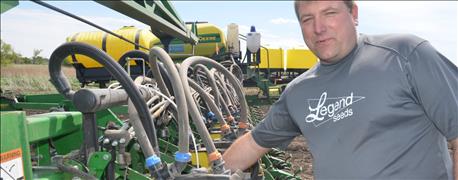January 25, 2016

Some Dakota farmers and agronomists are giving dual-hybrid planting high marks.
“It worked flawlessly,” says Jeff Lakner, Miller, S.D.
Last year, Lakner and about two dozen other farmers in South Dakota and North Dakota modified their planters so they could switch back and forth between different hybrids on-the-go. The GPS controlled equipment operates much the same way as a variable rate fertilizer applicator. But instead of a fertilizer prescription map, a planting prescription map controls the equipment.

Trav Bratland swtiched corn hybrids and soybeans varieties on the go to match management zones in his fields last year.
The farmers planted racehorse corn hybrids on their best ground and more defensive hybrids on their poorer ground. The goal was boost yields in both areas. Some did the same with soybeans.
The hope is that you won’t have to compromise and pick seed that will just do “okay” in both areas, says Brent Wiesenburger, precision ag manager, Wheat Growers cooperative, Aberdeen, S.D.
Trav Bratland, a farmer and Legends Seeds dealer from Willow Lake, S.D., even planted the Legend Seeds logo in one of his fields. He used two hybrids with different colored tassels. When the corn began to tassel, a picture of the logo emerged.
“I wanted to see how accurately the planter was going to be able to follow the prescription,” he says. “It was pretty amazing. It was accurate down to a few inches.”
20-30 bushel more
Dual planting increased corn yields for many of the farmers.
The precision ag team from Plains Grain and Agronomy, Enderlin, N.D., built replicated yield plots – which they call “learning blocks” -- into dual-hybrid planting prescription maps for about 20 clients across North Dakota. Those in the central and eastern parts of the state saw a 20-30 bushel per acre yield increase in the blocks that were planted with the hybrids selected specifically for that production zone. In western North Dakota, farmers documented a 10-15 bushel per acre gain, says Travis Messer, a Plains Grain and Agronomy precision ag specialist and Richardton, N.D., farmer.
“The goal is to take those areas where you might only get 0-50 bushels per acre and have them produce 50-100 bushels per acre or more,” Messer says.
Lakner says he saw a yield increase in his corn last year, but not 20-30 bushels per acre. However, he expects there’s even more upside potential that can be realized they learn which hybrids best fit different management zones in their fields.
The goal is to put hybrids in zones where they will realize their full yield potential, Lakner says.
Dual planting technology doesn’t come cheap, though. It costs about $2,500 per row to replace a planter’s conventional metering and drive system with dual systems on every opener. He also installed hydraulic downforce system on every row. Bratland spent about $60,000 to dual-up his 24-row John Deere 1770 planter last winter.
One way to reduce the cost is to not buy a single drive planter in the first place. Then, you don’t have to take off all the conventional drives and other equipment and replace them with dual drives. Plains Grain and Agronomy has developed such a planter, called the Precision MaXX. They start with a fully customizable, bare toolbar and add openers, Precision Planting’s dual metering system, individual row hydraulic downforce and other specialized equipment.
Goof fit for Dakotas
Good fit for Northern Plains
Investing in dual hybrid planting technology may be a good move for many Dakota farmers. It is especially well-suited for the Dakotas, Wiesenberger says, because fields are large and there is a great deal of variability in soil types, topography and drainage within fields.
“I think dual planting is the next big thing,” he says. “It is going to get us to the next yield level.”
You May Also Like




